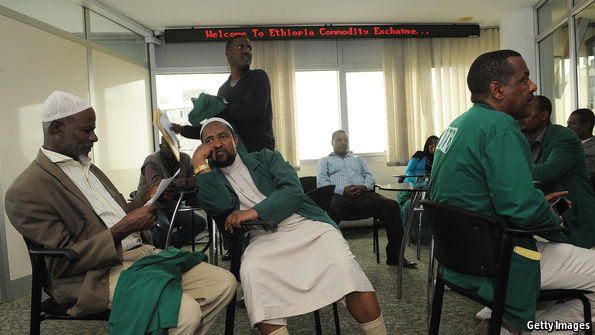Not as transformative as its founders hoped
Feb 4th 2017 | ADDIS ABABA
ON THE walls of the Ethiopia
Commodity Exchange (ECX) in Addis Ababa, the capital, hang glossy
black-and-white photographs of provincial market towns and rustic life. For the
merchants and brokers striding across its high-tech trading floor they serve as
a reminder that the ECX, sub-Saharan Africa’s most modern commodity exchange
outside Johannesburg, exists for a simple, practical purpose: to transform
Ethiopian agriculture.
It has some way to go. By connecting
smallholder farmers to global markets, the exchange, launched with a fanfare in
2008, was supposed to help reduce hunger. The hope was it would reduce price
volatility and incentivise farmers to plant crops. But staple foods such as
haricot beans today account for less than 10% of its trade. Its annual
turnover—worth about $1bn—is dominated instead by two export crops, coffee and
sesame seeds. In 2015, despite a dire drought, Ethiopia did avoid famine, but
the ECX played little role: its maize and wheat contracts had lapsed by then
because of concerns that exports would jeopardise domestic food supplies.
Cutting out middlemen seems not to have done much for smallholders: studies
suggest that the share of international prices received by coffee farmers has
barely budged over the past decade. Exporters complain about government
price-meddling.
The ECX’s founder, Eleni
Gabre-Madhin, who left the exchange in 2012, worries that momentum has been
lost. The exchange remains restricted to simple spot-trading. Futures
contracts, which help traders manage price fluctuations, were supposed to be
introduced within five years, but are still some way off.
In July 2015 the ECX did, however,
introduce electronic transactions, now used for almost all trades. Bespoke
software is built in-house by Ethiopian engineers. Payments the day after
purchase are guaranteed. The ECX can also boast never to have seen a default,
in a country known for suicides by indebted farmers whose buyers have welshed.
Ethiopia has shown that it is possible for an exchange to prompt the physical
infrastructure of commodities markets: the ECX oversaw a burst in warehouse
construction.
Fledgling exchanges dotted around
Africa often visit Addis Ababa to study the ECX. But experts doubt it is a
helpful model. The government made it viable by mandating that almost all trade
in coffee and some other commodities go through the exchange. This might not be
possible elsewhere. A monopoly imposed by fiat makes it more like a state
marketing board than an exchange, says Thomas Jayne, an economist at Michigan
State University.
Another model might be the
Agricultural Commodity Exchange for Africa in Malawi, which was set up
privately in 2006 at the request of an association of smallholder farmers. But
its volumes remain low. And its concentration on staple foods such as maize and
soya leaves it vulnerable to the sort of government interventions that can sink
exchanges. Trading in staples tends to be politically sensitive in times of
food scarcity.
Setting up national exchanges may be
the wrong approach. The Johannesburg Stock Exchange plans to introduce a
regional contract for Zambian white maize later this year. For lucrative export
crops like coffee, well-established offshore exchanges may make more sense than
starting from scratch at home. Better a functioning exchange somewhere else
than a disappointing one on the doorstep.
---

No comments:
Post a Comment
Join the conversation